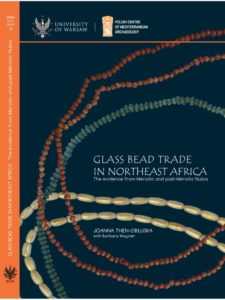-
BUY ONLINE SEE IN CEEOL
-
Joanna Then-Obłuska with Barbara Wagner, Glass bead trade in Northeast Africa. The evidence from Meroitic and post-Meroitic Nubia (=PAM Monograph Series 10), Warszawa: PCMA UW, WUW, 2019
Warsaw 2019
ISBN 978-83-235-3899-8
https://doi.org/10.31338/uw.9788323539070
316 pages
Soft cover with flapsStrings of colorful glass beads were a popular commodity traded throughout ancient Nubia in the earlier half of the first millennium AD. Combining macroscopic examination with laboratory analyses, the author breaks new ground in Nubian studies, establishing diagnostic markers for a study of trading markets and broader economic trends in Meroitic and post-Meroitic Nubia.
Archaeometric results, lucidly presented and discussed, identify the origins of the glass from which the beads under investigation were made. The demonstrated South Indian/Sri Lankan provenance of some of the ready-made beads from Nubian burial contexts and a reconstruction of their distribution patterns in Northeast Africa is the first undisputed proof of contacts between Nubia and the Red Sea coast. Reaching beyond that, it shows Nubia’s involvement in the Asian maritime trade, whether directly or indirectly, during a period of intensive interchanges between the 4th and 6th centuries AD.
The study was funded from the National Science Centre grant DEC-2013/09/D/HS3/04508 for the project A reconstruction of trade contacts in Northeast Africa: an interdisciplinary analysis of Nubian personal adornment directed by Dr Then-Obłuska and afiliated at the PCMA .
Joanna Then-Obłuska is a researcher at the University of Warsaw and an Associate of the Oriental Institute of the University of Chicago, specializing in the archaeology of Northeast Africa. She received her PhD in Archaeology from the Jagiellonian University (2008). Since then her projects have focused primarily on issues of society and trade, looking at ancient Sudanese and Egyptian beads and jewelry in terms of both material and bead-making techniques. She uses archaeometric results to understand the economic role of bead imports during the time of an intensive Indian Ocean trade. Recently, her research has branched off into Ethiopia.
For download:
Reviews:
-
- Marilee Wood (2020). Glass bead trade in Northeast Africa: the evidence from Meroitic and post-Meroitic Nubia, Azania: Archaeological Research in Africa, DOI: 10.1080/0067270X.2020.1769930
“In this well-produced book Then-Obluska combines results from morphological studies and chemical analysis of 170 glass beads and pendants excavated from graves dated to the Meroitic and post-Meroitic periods as a means to study trade between Nubia and neighbouring regions from the third century BC to the sixth century AD. The results of the chemical analysis are used to trace the origins of the raw glass while bead manufacturing locations are explored through morphological examination, particularly production technique.”
-
- Karlis Karklins (2019). Glass Bead Trade in Northeast Africa: The Evidence from Meroitic and Post-Meroitic Nubia, Beads, Journal of the Society of Bead Researchers 31, 121–122
“This volume presents much new data on Nubian beads and is the first study to provide evidence of the presence of beads of Egyptian, Levantine, and South Indian/Sri Lankan glass in Nubia. While some of the contents may be too technical for the average bead enthusiast, those studying or collecting pre-Islamic beads will surely find this handsome and well-written book of interest. Likewise, the section on glass chemistry will be welcomed by those aiming to identify bead sources.
-
